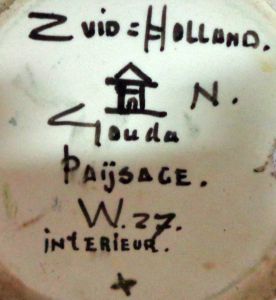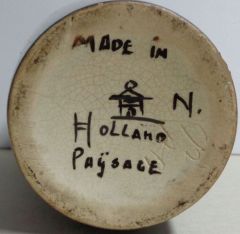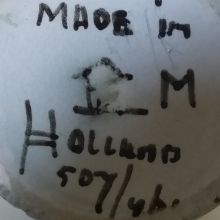The painter for the N-signature.
In many cases it is quite easy to work out who painted a particular piece
of pottery. Once you know when a piece was made, you look up the initials
of the painter for that date in lists that show who worked for the PZH at
that time. (The lists can be found in various books about Gouda pottery.)
For Gouda pottery created before 1918 (Like the ones below) it is harder
to determine who the painter is. That is because the marks they used were
not as complete and not very standard. In the early days of the PZH when
there were not too many employees; the painters often used just the first
letter of their surname as their signature. This could make it confusing
because they sometimes used letters to signify the year in which the piece
was made, and they sometimes added codes to the mark. In later years they
used the initial of both their first name and surname, which made it a
little easier.
From 1898 to 1917 much of the pottery goes without an exact date mark. And
when you find a letter, you cannot always work out if it stands for a
date, a painter initial or just a code used during the manufacturing
process.
Date marks used in the early days had an “A” in 1898, a “B” in 1899 and so
on, This continued to about 1905, and certainly not all items were marked
consistently.
With the marks below it also helps that there are a number of different
vases to look at. The marks are different enough to tell that they are not
for the same order or the same batch. Also the clay and glaze used is
different between the vases and probably not all made in the same year.
(In the earlier years they used the softer, locally found, somewhat
coloured clay).
All up, the “N” is likely to be the initial of the surname of the painter.
Another smaller indication is that the “N” is also followed by a full
stop. This means that the “N” is probably an abbreviation. (i.e the
Initial of his surname) and therefore not a code.
(For pictures of the vases themselves, please browse the Paijsage-section
in the Gallery.)
On the Internet I also managed to find some other examples of pottery made
at a later date, (around 1920) that also have a signature of just an "N"
but with a different writing style.
But then it all matches up when you find that 2 painters worked at the PZH
in the early 1900's with a surname starting with "N".
- Willem Nales born in 1880, and worked for the PZH
from 1907 to the mid 1912's .
- Wouter Anthony Nonner born in 1899 and with the PZH
from 1915 to 1934.
Mr. Nonner started to work for the PZH in 1915, he was a 16 year old boy
at that time, It is not likely that he would have created the variety of
Paijsages that I have seen with these markings, plus I believe some or all
were painted before he got there. He is probably the painter of the other
pieces I found on the Internet with date marks around the 1920's.
That leaves me with Willem Nales as the likely painter associated with the
marks above.
Below is another mark of a paysage painted by Willem Nales. The markings
are quite a bit different from those above. The words "Zuid-Holland" are
missing, and instead it says "made in Holland". The vase was made for
export into other countries The company started exports from the
early 1900's.
It becomes more interesting again when you find this unique writing on
other pottery of that time, look at the mark and picture below.
Another paysage and the writing style is so similar to what I showed
above, that at first I thought Mr Nales painted this one as
well. The mark has the same "H" with the double horizontal line,
also the "N" with its right leg extending down as is visible on the body
of the vase, is the same. But then interestingly enough I found
similar vases with the JVS (Jan van Schiack) painter mark, The handwriting
on these vases was just about identical to the ones above.
So that leaves the question of what the “M” in the mark above stands for.
It is not a year code, because they did not use them anymore around 1910.
It is most likely a a painter initial, and the painter could be Willem
Mica who worked for the PZH around 1912.
Some other vases with the "N"-Initial can be found in the
"paijsage"-section.
And finally a
LINK to the other painter with ths same "N" signature.



